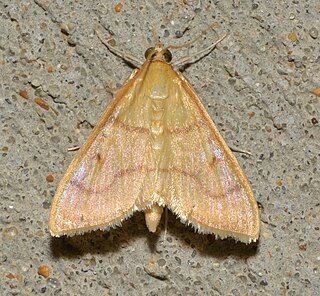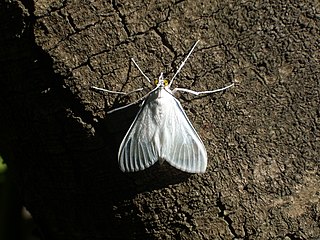Petrophila schaefferalis is a moth in the family Crambidae. It was described by Harrison Gray Dyar Jr. in 1906. It is found in Mexico (Xalapa) and the southern United States, where it has been recorded from Arizona, California and Texas.
Trischistognatha pyrenealis is a moth in the family Crambidae. It was described by Francis Walker in 1859. It is found in Mexico, Central America, the West Indies and the southeastern United States, where it has been recorded from Georgia to Florida and from Alabama to Texas.
Dichogama colotha is a moth in the family Crambidae. It is found in Costa Rica, Mexico and the United States, where it has been recorded from Texas. It is also found in Puerto Rico.
Hahncappsia alpinensis is a moth in the family Crambidae. It was described by Hahn William Capps in 1967. It is found in North America, where it has been recorded from Arizona, New Mexico and Texas.

Hahncappsia fordi is a moth in the family Crambidae. It was described by Hahn William Capps in 1967. It is found in the south-western United States, where it has been recorded from California and Arizona, as well as Sonora, Mexico.
Hahncappsia pseudobliteralis is a moth in the family Crambidae. It was described by Hahn William Capps in 1967. It is found in North America, where it has been recorded from Arizona and Texas. It has also been recorded from Morelos, Mexico.
Hahncappsia jaralis is a moth in the family Crambidae. It was described by William Schaus in 1920. It is found in the United States in southern Arizona and in Mexico in Oaxaca, Puebla, Jalisco and San Luis Potosí.
Helvibotys pseudohelvialis is a moth in the family Crambidae described by Hahn William Capps in 1967. It is found in the United States, where it has been recorded from western Texas to Arizona and California and in Utah. It is also present in Sonora, Mexico.

Neohelvibotys neohelvialis is a moth in the family Crambidae. It was described by Hahn William Capps in 1967. It is found in the United States, where it has been recorded from Georgia and Florida to Arizona, as well as in the West Indies and from Mexico to Panama.
Neohelvibotys arizonensis is a moth in the family Crambidae described by Hahn William Capps in 1967. It is found in Mexico and United States, where it has been recorded from southern Arizona.
Sisyracera subulalis is a moth in the family Crambidae. It was described by Achille Guenée in 1854. It is found on the West Indies and from Florida and Texas, through Mexico, Honduras and Costa Rica to Ecuador, Suriname and Brazil.
Scoparia anadonta is a moth in the family Crambidae. It was described by Harrison Gray Dyar Jr. in 1918. It is found in Hidalgo, Mexico.
Choristostigma perpulchralis is a moth in the family Crambidae. It is found in Mexico and the United States, where it has been recorded from New Mexico and Texas.
Conchylodes concinnalis is a moth in the family Crambidae. It is found in Mexico and the south-eastern United States north to Ohio. In the west the range extends to Arizona and southern California.

Conchylodes ovulalis, the zebra conchylodes moth, is a moth in the family Crambidae. It was described by Achille Guenée in 1854. It is found from the United States, where it has been recorded from Pennsylvania to Florida, west to Arizona, south through Mexico and Costa Rica to Colombia.

Hileithia magualis is a moth in the family Crambidae. It was described by Achille Guenée in 1854. It is found in the Dominican Republic, Jamaica, Cuba, and the southern United States, where it has been recorded from Alabama, Arizona, Florida, Mississippi, Missouri, New Mexico, Oklahoma and Texas.

Lineodes fontella, the eastern lineodes moth, is a moth in the family Crambidae. It was described by Walsingham in 1913. It is found in the United States, where it has been recorded from Florida, North Carolina, South Carolina and Texas. Outside of the States, it is found in Jamaica, Cuba, the Dominican Republic, Mexico, Panama, Guatemala, Honduras, Brazil, French Guiana and Guyana.
Loxomorpha flavidissimalis is a moth in the family Crambidae. It was described by Augustus Radcliffe Grote in 1877. It is found in the United States, where it has been recorded from Texas, Florida, North Carolina and West Virginia. It is also found in Mexico and Puerto Rico. It has also been recorded from Australia.

Palpita flegia, the satin white moth, is a moth in the family Crambidae. It was described by Pieter Cramer in 1777. It is found in Suriname, Colombia, Brazil, Honduras, Nicaragua, Costa Rica, Panama, Mexico, the Caribbean and the United States, where it has been recorded from Alabama, Florida and Texas.
Phostria tedea is a moth in the family Crambidae. It was described by Stoll in 1780. It is found in the southern United States, where it has been recorded from Arizona, to Central America, including Mexico, Costa Rica and Belize.





